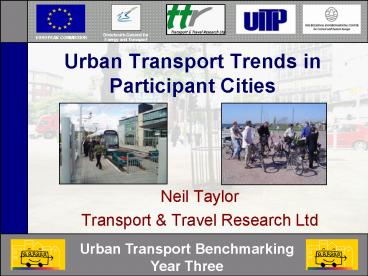Urban Transport Trends in Participant Cities PowerPoint PPT Presentation
1 / 23
Title: Urban Transport Trends in Participant Cities
1
Urban Transport Trends in Participant Cities
Directorate-General for
Energy and Transport
EUROPEAN COMMISSION
- Neil Taylor
- Transport Travel Research Ltd
2
Introduction
- Background
- Data collected
- Key findings
- EU enlargement context
- Examples from Southern Europe
- New Member State trends
- Key Challenges
- Ideas for NMS cities
3
Background
- First defined in 2003, now in 3rd evolution
- Common indicators ? quantitative data.
- Data gathered in yr3 similar to yr 2
- Effective baseline dataset now created
- Aim of yr 3 analysis delve deeper
4
Data Collected Common Indicators
1.1 Area of region 1.2 Area of city 1.3
Population of region 1.4 Population of city 1.5
Geography 2.1 Fixed routes 2.2 Flexible
routes 2.3 Public transport priority 2.4
Cycling space in the city 3.1 Car ownership 3.2
Public transport fleet 3.3 PT Accessibility 3.4
Clean Vehicles
4.1 Average speed (private transport) 4.2
Average speed (public transport) 4.3 Service
intervals 4.4 Modal split 4.5 Total passengers
carried 4.6 Farebox revenue 5.1 Cost of car
use 5.2 Cost of public transport 5.3 Investment
in public transport 5.4 Investment in roads 5.5
Gross Domestic Product 5.6 Employment 6.1
Traffic accidents
5
Key Findings
- Higher GDP per capita ? Higher Car modal share
and lower PT modal share - Urban metro systems most extensive in bigger
cities. Approx. threshold 40-45km of metro per
1million population. - Metros encourage significantly greater PT use in
cities.
6
Wealthier cities drive more
7
and use public transport less
8
Metro systems Critical Mass (1)
9
Metro systems Critical Mass (2)
10
Metro systems - Driving PT use
11
Common Indicators Reporting
- Detailed findings and trends in final report
- Due to be published end summer 2006
- Also identified trends in New Member State (NMS)
Accession Country cities
12
NMS/Accession Country Cities
- 7 cities from NMS/Accession Countries involved
- Suceava
- Bucharest
- Budapest
- Gdansk
- Warsaw
- Prague
- Sofia
- Since we are in Budapest today
- It seems appropriate to look at some of the
NMS/Accession city trends!
13
EU Enlargement - context
- EU Enlargement in 2004
- Slovenia to enter Eurozone Jan 1st 2007
- Rapid economic growth expected
- Inward investment triggering growth
- Pressure for transport links
- Expected increase in disposable incomes?
- Increase in car ownership?
14
Comparison with Southern Europe
- Athens, Lisbon, Alicante, Palma, Barcelona
Madrid - In states which joined EU in 1981 and 1986
- Rapid economic growth followed accession
- Large increases in car ownership use (Lisbon)
- Unplanned urban development (e.g. Athens)
- Current policies seek to resolve problems of
rapid growth. - Could NMS cities learn from these experiences?
15
NMS/EU15 city comparisons - 1
- NMS cities generally demonstrate high levels of
public transport modal share (gt 50) - The real cost of PT can be greater in NMS cities
than in EU15 cities - Car ownership levels are generally lower in NMS
cities. - BUT Vast differences also exist between NMS
cities - Pragues economy relatively strong (gt EU15 avg.
GDP per Capita)
16
Intensity of PT use
17
Public transport fares in real terms
18
NMS/EU15 city comparisons - 2
- Clean Vehicles less apparent in NMS cities bus
fleets ? trickle down of technology? - Public transport often inaccessible for people
with reduced mobility (0.3 to 30 of bus fleets)
- Trolley buses and first generation tram systems
are most predominant in NMS cities - Significantly less road-space in NMS cities
Prague the exception
19
Accessibility of bus fleets
20
Km of Road Space per 1000 inhabitants
21
Key Challenges
- Funding Issues
- Who will fund transport provision in NMS cities?
- Affordability of clean/accessible vehicle fleets
- Involvement in these benchmarking projects
- Investment Pressure
- Will FDI drive the NMS cities urban transport
agenda? - Increased road/motorway capacity a priority for
investors? - Links to EU15 rather than other NMS cities?
- Possible need for socially inclusive approach to
managing growth
22
Ideas for NMS Cities
- Pre-emptive land-use transport planning
- Spread investment beyond growth poles
- Maintain a quality public transport alternative
- Apply EU15 good practice examples in NMS cities
- Careful use of restrictive measures
- Balance the need to attract FDI with development
control
23
Thank you for listening
- Project Contacts
- E-mail benchmarking_at_ttr-ltd.com
- Web www.transportbenchmarks.org
- Tel 44 (0) 1543 416416
- Kieran Holmes, Sarah Clifford,
- Neil Taylor, Ben Smith

